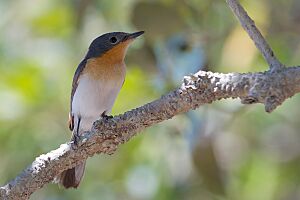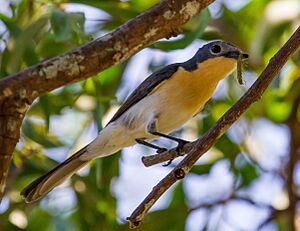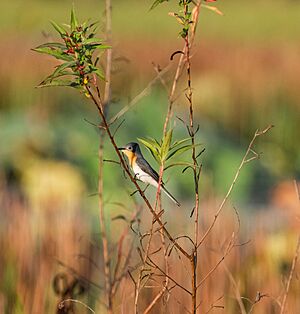Broad-billed flycatcher facts for kids
Quick facts for kids Broad-billed flycatcher |
|
|---|---|
 |
|
| Conservation status | |
| Scientific classification | |
| Genus: |
Myiagra
|
| Species: |
ruficollis
|
| Subspecies | |
|
See text |
|
| Synonyms | |
|
|
The broad-billed flycatcher (Myiagra ruficollis) is a small, active bird. It belongs to the Monarchidae family, which includes many types of flycatchers. You can find this bird in warm, tropical places. It lives in northern Australia, the Lesser Sunda Islands, and southern New Guinea.
These birds prefer specific homes. Their natural habitats include moist lowland forests, mangrove forests, and moist mountain forests. They love places with lots of trees and water.
Contents
About the Broad-billed Flycatcher
Scientists give animals special names to help us understand them better. The broad-billed flycatcher's scientific name is Myiagra ruficollis. It was first described by a scientist named Louis Pierre Vieillot in 1818.
Sometimes, different birds can have similar common names. For example, the name "broad-billed flycatcher" is also used for another bird called the Melanesian flycatcher. This is why scientific names are so important! They help avoid confusion.
Different Types of Broad-billed Flycatchers
Just like there can be different breeds of dogs, there are different types of broad-billed flycatchers. Scientists call these "subspecies." There are three main subspecies recognized:
- M. r. ruficollis: This type lives on the southern and eastern Lesser Sunda Islands. You can also find it on islands in the Flores Sea.
- Buff-bellied flycatcher (M. r. fulviventris): This subspecies lives on the Tanimbar Islands. For a while, scientists thought it was a completely separate species! It's also sometimes called the Tanimbar flycatcher.
- M. r. mimikae: This type is found in southern New Guinea and the Aru Islands. It also lives on islands in the Torres Strait and in northern and northeastern Australia.
What Does It Look Like and Where Does It Live?
The broad-billed flycatcher is a small bird, usually about 14 to 17 centimeters long. That's about the size of a small ruler!
In northern Australia, you'll often spot these birds in moist forests. They also like scrubby areas near fresh water, like billabongs (small lakes) and wet season marshes. These places provide plenty of insects for them to eat.
What Do They Eat?
Broad-billed flycatchers are insect eaters! They spend their time high up in the forest canopy, which is the top layer of trees. Here, they hunt for insects and other small invertebrates.
Unlike some other flycatchers, the broad-billed flycatcher usually stays within the trees. It doesn't often fly out into open areas to catch insects. It prefers to find its meals hidden among the leaves and branches.




